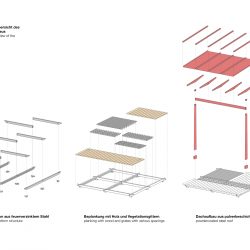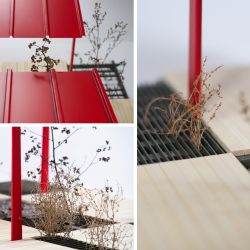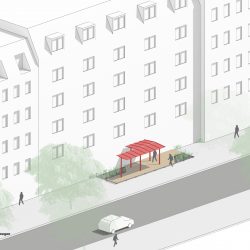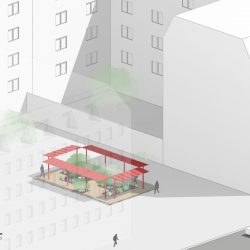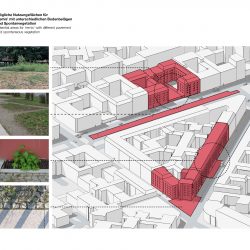Remis
Description
‚Remis‘ is an object and furniture system for the public urban space. It creates quality of stay in neglected areas with little intervention, temporary or permanent. ‚Remis‘ consists of platforms, shelters and cutouts for spontaneous vegetation. Combined, open rooms are created: terraces, islands and pavilions.What is the Topic?
Considering the expansion of metropole regions in our environment, the search for wild places in the last corners of the earth for the purpose of leisure tourism makes little sense. This state of mind has set a boundary between the human and natural world, physically and culturally. At the same time public urban space is being privatized and commercialized, reserved for mobility and consumption. Encounters with nature cannot and should not be expelled to separated areas. ‚Remis‘ aims to raise awareness for the differentiating details and shared characteristics between nature and culture within our living environment.
Why does it look like this?
The object itself, as platform, bench or pavilion is strictly structured. The result is a grid system on which planks and grates with different spacings are mounted, to allow various plants to grow through, creating a blurred line between uncontrolled vegetation and places to relax. At the same time ‚Remis‘ has the intention to answer to current moods connected to experiences in nature. That can be the desire for simplicity, solitude and security. Therefore form and surface refer to contemporary outdoor lifestyles as well as details associated with traditional cultural sites, using an understandable construction.
What is special?
The concept questions the uncompromising sealing of soil and green areas in cities that require intensive maintenance. The modules can be set up on any ground. Through the cracks and gaps in the pavement different plants will grow, which in turn create biotopes for various organisms. An actual, uncontrolled nature is focussed: There is no maintenance nor trimming. An important feature of the design is the temporary moment: ‚Remis‘ can be mounted and demounted again and again. The platforms allow the soil to breathe, as the construction does not aim to stay on one spot for decades. This attitude empowers the idea to leave so called 'neglected' urban spaces to themselves as a sanctuary for nature and people alike. In order to cherish such areas, no masterplans are needed, but small interventions with objects that influence our perception.
What is new?
Compared to major urban planning projects, industrial design has the advantage of working more speculatively and from a larger distance to specific geographical sites. Products can adapt to different contexts, reconfigurations of landscapes do so to a lesser extent. The task for designers should not be to find compensations for an uncomfortable life in the city. Instead of a distractive satisfaction of questionable desires, we should think about changes in our everyday life, that answer the need for contact with nature and related emotions. These new free spaces need to be recognized and furnished within city limits.


